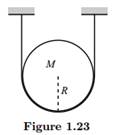
The world’s Largest Sharp Brain Virtual Experts Marketplace Just a click Away

Levels Tought:
Elementary,Middle School,High School,College,University,PHD
| Teaching Since: | May 2017 |
| Last Sign in: | 305 Weeks Ago, 3 Days Ago |
| Questions Answered: | 66690 |
| Tutorials Posted: | 66688 |
MCS,PHD
Argosy University/ Phoniex University/
Nov-2005 - Oct-2011
Professor
Phoniex University
Oct-2001 - Nov-2016
Supporting a disk
(a) A disk of mass M and radius R is held up by a massless string, as shown in Fig. 1.23. The surface of the disk is frictionless. What is the tension in the string? What is the normal force per unit length the string applies to the disk?
(b) Let there now be friction between the disk and the string, with coefficient ¬Ķ. What is the smallest possible tension in the string at its lowest point?

Sol:
Supporting a disk
(a) The gravitational force downward on the disk is Mg, and the force upward is 2T. These forces must balance, so
![]()
We can find the normal force per unit length that the string applies to the disk in two ways. First method: Let N dőł be the normal force on an arc of the disk that subtends an angle dőł. Such an arc has length R dőł, so N/R is the desired normal force per unit arclength. The tension in the string is constant because the string is massless, so N is constant, independent of őł. The upward component of the normal force is N dőł cos őł, where őł is measured from the vertical (that is, ‚ąíŌÄ/2 ‚ȧ őł ‚ȧ ŌÄ/2 here). Since the total upward force is Mg, we must have

Second method: Consider the normal force, N dőł, on a small arc of the disk that subtends and angle dőł. The tension forces on each end of the corresponding small piece of string almost cancel, but they don‚Äôt exactly, because they point in slightly different directions. Their non-zero sum is what produces the normal force on the disk. From Fig. 1.43, we see that the two forces have a sum of 2T sin(dőł/2), directed inward. Since dőł is small, we can use sin x ‚Čą x to approximate this as T dőł. Therefore, N dőł = T dőł, and so N = T. The normal force per unit arclength, N/R, then equals T /R. Using T = Mg/2 from eq. (1.29), we arrive at N/R = Mg/2R.
(b) Let T(őł) be the tension, as a function of őł, for ‚ąíŌÄ/2 ‚ȧ őł ‚ȧ ŌÄ/2. T will depend on őł now, because there is a tangential friction force. Most of the work for this problem was already done in the example at the end of Section 1.1. We will simply invoke the second line of eq. (1.7), which says that8
 

This minimum value of T(0) goes to Mg/2 as ¬Ķ ‚Üí 0, as it should. And it goes to zero as ¬Ķ ‚Üí ‚ąě, as it should (imagine a very sticky surface, so that the friction force from the rope near őł = ŌÄ/2 accounts for essentially all the weight). But interestingly, it doesn‚Äôt exactly equal zero, no matter now large ¬Ķ is.

Hel-----------lo -----------Sir-----------/Ma-----------dam-----------Tha-----------nk -----------You----------- fo-----------r u-----------sin-----------g o-----------ur -----------web-----------sit-----------e a-----------nd -----------acq-----------uis-----------iti-----------on -----------of -----------my -----------pos-----------ted----------- so-----------lut-----------ion-----------.Pl-----------eas-----------e p-----------ing----------- me----------- on-----------cha-----------t I----------- am----------- on-----------lin-----------e o-----------r i-----------nbo-----------x m-----------e a----------- me-----------ssa-----------ge -----------I w-----------ill----------- be-----------